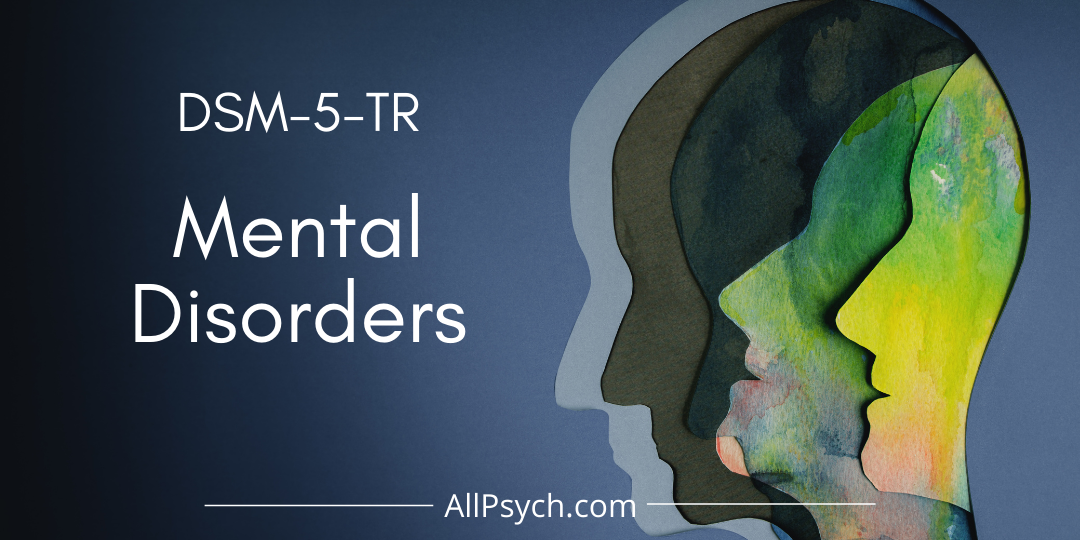
Mental Disorders - DSM-5-TR

Read More

Read More

Read More
 There are over 300 different psychiatric disorders listed in the DSM-IV. With continued research, more are named every year and some disorders are removed or re-categorized. AllPsych includes in these pages the etiology (how it develops), symptoms, treatment options, and prognosis for over 60 adult psychiatric disorders and 8 personality disorders, as well as the names and DSM Codes for over 150 disorders.
There are over 300 different psychiatric disorders listed in the DSM-IV. With continued research, more are named every year and some disorders are removed or re-categorized. AllPsych includes in these pages the etiology (how it develops), symptoms, treatment options, and prognosis for over 60 adult psychiatric disorders and 8 personality disorders, as well as the names and DSM Codes for over 150 disorders.
Click a category to be taken to the description and list of disorders for that category or click Disorder Index for a complete list of disorders, Categories, and DSM-IV Codes.
Categorizing Mental Illness
Psychiatric Diagnoses are categorized by the Diagnostic and Statistical Manual of Mental Disorders, 4th. Edition. Better known as the DSM-IV, the manual is published by the American Psychiatric Association and covers all mental health disorders for both children and adults. It also lists known causes of these disorders, statistics in terms of gender, age at onset, and prognosis as well as some research concerning the optimal treatment approaches.
Mental Health Professionals use this manual when working with patients in order to better understand their illness and potential treatment and to help 3rd party payers (e.g., insurance) understand the needs of the patient. The book is typically considered the ‘bible’ for any professional who makes psychiatric diagnoses in the United States and many other countries. Much of the diagnostic information on these pages is gathered from the DSM IV.
Diagnosing
There is a good deal of overlap among the different diagnoses listed in the DSM IV, which you may notice by browsing these pages. The reason for this is the same as for the overlap in medical diagnoses...rarely is a symptom exclusive of anything, and rarely can a diagnosis be made without a pattern or cluster of symptoms. For example, Depression includes feelings of sadness, but anxiety can lead to sadness, as can phobias, psychosis, and many other disorders. Keep this in mind when reading about specific diagnoses or you may find yourself saying way too frequently "Oh my Gosh, I have that."
Diagnoses can only be made by a clinician (e.g., psychologist or psychiatrist) who specializes in these areas and who understands the symptom patterns and idiosyncrasies of each disorder. Don’t self diagnose. If you feel you may have symptoms which are negatively affecting your life, please seek the advice and assistance of a professional.
Categories and Disorders
Mental Disorders are categorized according to their predominant features. For example, phobias, social anxiety, and post-traumatic stress disorder all include anxiety as a main feature of the disorder. All of these disorders are therefore categorized under Anxiety Disorders.
The list on the left includes a link to the adult categories which will then link you to specific disorders in that category. For a complete listing of all disorders covered, use the Alphabetical Index. There's a lot of information here so please keep in mind that reading this information does not make you an expert in the nuances of mental health. These pages are provided to increase your knowledge and help guide you to a better understanding of psychopathology.
- Alphabetical Index of Disorders
- Attention Deficit Hyperactivity Disorder (ADHD)
- Dissociative Disorders
- Anxiety Disorders
- Eating Disorders
- Adjustment Disorders
- Impulse Control Disorders
- Mood Disorders
- Paraphilias
- Sleep Disorders
- Psychotic Disorders (including Schizophrenia)
- Sexual Disorders and Dysfunctions
- Somatoform Disorders
- Substance Related Disorders
- Personality Disorders
